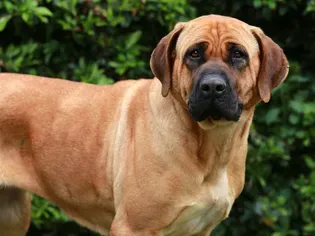Tosa (Tosa Inu): Dog Breed Characteristics & Care
Updated on 05/26/24

Discover the Enigmatic Tosa Inu: A Comprehensive Guide to Breed Characteristics and Care
Introduction:
In the realm of canine companions, the Tosa Inu stands out as a formidable and enigmatic breed. Originating from the rugged mountains of Tosa, Japan, these powerful dogs have captivated dog enthusiasts with their striking appearance and unwavering loyalty. This comprehensive guide will delve into the distinctive characteristics, temperament, and meticulous care required for this exceptional breed.
Physical Attributes:
* Size and Weight: Tosa Inus are massive dogs, with males averaging 2 feet in height and weighing between 120-200 pounds. Females are slightly smaller, standing at around 2 feet tall and weighing around 80-140 pounds.
* Coat: The Tosa Inu's double coat consists of a short, dense undercoat and a straight, coarse outer layer. While most Tosas exhibit a brindle or solid fawn coat, variations in color, including black, red, and sesame, are also present.
* Head: The breed's head is large and broad, resembling that of a bullmastiff. Its jaws are powerful, with a pronounced underbite that adds to its formidable appearance.
* Muscles: Tosa Inus possess exceptional muscular development, particularly in the shoulders, chest, and hindquarters. Their athletic build reflects their hunting and fighting heritage.
Temperament and Personality:
* Loyal and Protective: Tosa Inus are highly devoted to their families and make excellent guard dogs. Their strong protective instincts make them wary of strangers and other animals outside their pack.
* Independent and Reserved: Despite their unwavering loyalty, Tosa Inus can also be independent and reserved, especially with individuals they do not know well. They prefer the company of their trusted humans and may be aloof towards newcomers.
* Dominant and Courageous: Tosa Inus are known for their dominant personalities and courageous nature. They require strong and experienced owners who can establish clear boundaries and provide consistent training.
Care and Maintenance:
* Exercise: As highly active dogs, Tosa Inus require ample exercise to maintain their physical and mental well-being. Regular walks, hiking, or playtime in a secure yard are essential for their happiness.
* Diet: Tosa Inus have specific nutritional requirements due to their large size and muscular development. A high-quality diet rich in protein and moderate in fat is crucial for their growth and maintenance.
* Grooming: While their short coat is relatively low-maintenance, Tosa Inus require regular brushing to remove dead hair and keep their skin healthy. Bathing only needs to be done on an as-needed basis.
* Health: Tosa Inus are generally healthy dogs with an average lifespan of 10-12 years. However, they may be prone to certain health conditions such as hip dysplasia, bloat, and eye problems.
* Training and Socialization: Early socialization and obedience training are essential for Tosa Inus. Their dominant nature requires experienced handlers who can establish clear leadership while fostering trust and respect. Without proper training, Tosas can become difficult and potentially dangerous.
Examples of Tosa Inu Care:
* Meal Plan: Divide your Tosa Inu's daily food into two meals, feeding them in the morning and evening. Adjust the portion size based on their age, weight, and activity level.
* Training Session: Begin training your Tosa Inu puppy with basic commands such as "sit," "stay," and "come." Use positive reinforcement and treats to motivate them and build a bond.
* Grooming Routine: Brush your Tosa Inu's coat once a week using a slicker brush to remove loose hairs and dirt. Avoid over-bathing as it can strip their skin of natural oils.
Conclusion:
The Tosa Inu is an exceptional breed that demands respect, admiration, and unwavering commitment. Their formidable appearance, loyal nature, and independent spirit make them suitable only for experienced and dedicated dog owners. By understanding their unique characteristics and providing them with the necessary care and training, you can forge an unbreakable bond with this enigmatic canine companion.
Explore More Pets

Basic Training
Puppy and Baby Introductions

Working Dog Breeds
All About Search and Rescue Dogs

Dog Treatments
Puppy Vaginitis: Signs, Causes and Treatment

Dog Adoption
After More Than 1,200 Days in the Shelter, Coco Goes Home

Basic Training
How to Train Your Puppy to Go on Potty Pads

Hybrid Dog Breeds
The Difference Between a Mutt, Mixed Breed, or Designer Dog?

Dog Treatments
Nail Problems in Dogs

Puppies
7 Reasons Why Two Dogs Are Better Than One
